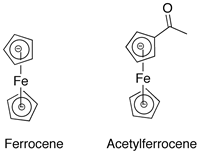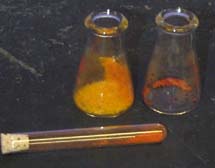Students started week two of organic chemistry with their first major test. They didn’t get much rest time after though, as they jumped right back into lab the next day. This week students will be leaning how to use NMR spectroscopy as another tool for identifying organic compounds. NMR (nuclear magnetic resonance) treats the nucleus of different atoms as tiny magnets and subjects them to an oscillating external magnetic force. The nuclei will resonate differently depending on how the are bonded to their neighbors and what their neighbors are. If you’ve ever had an MRI at the doctors, you’ve experienced a type of NMR. Students will be given an unknown compound and asked to identify it using the NMR and IR.
Students will also learn about different types of chromatography this week. Chromatography is a general term referring to lab techniques that are used to separate compounds from one another. They first will use column chromatography to separate ferrocene and acetyl ferrocene.
Both molecules contain iron and two five member rings, but acetyl ferrocene also contains an additional functional group. This functional group will allow acetyl ferrocene to move through a silica gel column at a different speed than the ferrocene. The originally dark orange solution of a combination of the two compounds will come out in two bands, a yellow one and a light orange one.
Students will then use thin-layer chromatography (TLC) to compare the separation on their own compounds against pure standards. With TLC, students dot small drops of their sample on silica coated plastic. The plastic is then placed in a small amount of liquid and the liquid will carry the dots up the plate at different rates depending on the structure of the compound.
On this sample TLC plate, the mixed sample is spotted in the the middle and a pure samples lay on either side.


